Timeline and Sources of History Chapter Notes | Chapter Notes For Class 6 PDF Download
| Table of contents |

|
| The Earth's Long History and Our Place in It |

|
| How Is Time Measured in History? |

|
| What Are the Sources of History? |

|
| The Beginnings of Human History |

|
| The First Crops |

|
| Key Words |

|
The Earth's Long History and Our Place in It
Think about the earliest memory you can recall. How old were you at that time? These memories are part of your past and help shape who you are today. Similarly, the history of the Earth helps us understand the present world. Scientists have discovered that the Earth has a very long history, and humans have been a part of it only for a tiny and very recent period.
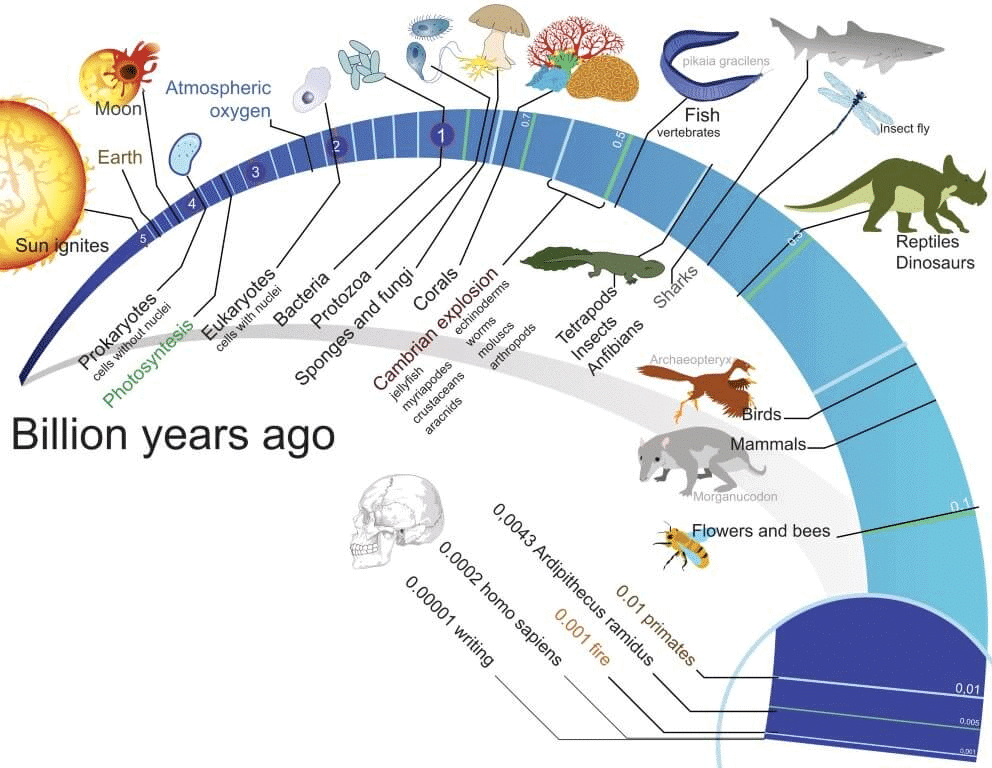
Timeline of a few important stages in the evolution of life on Earth.
How Do We Learn About the Past?
Many people study the history of the Earth.
- Geologists: They study the physical features of the Earth, such as soil, stones, hills, mountains, rivers, seas, and oceans.
- Paleontologists: They examine the remains of plants, animals, and humans from millions of years ago through fossils.
(Fossils: Impressions of footprints, or parts of plants or animals found preserved within layers of soil or rocks.) - Anthropologists: They study human societies and cultures from ancient times to the present.
- Archaeologists: They dig up remains left by people, plants, and animals, such as tools, pots, toys, bones, teeth, and parts of houses.

How Is Time Measured in History?
Can you identify which calendar is most widely used around the world today?
Yes, the Gregorian calendar is the most widely used around the world today. It is commonly used for civil purposes, while other calendars, such as the Hindu, Muslim, Jewish, and Chinese calendars, are often used for religious festivals and special occasions.
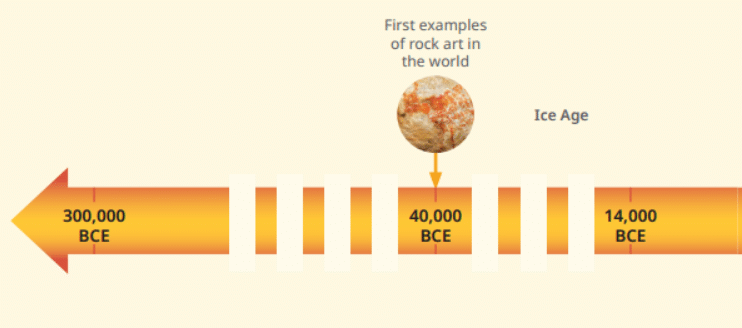
Timeline of some main events since 300,000 BCE
- Measuring Time in History: Different societies and cultures have their own ways of measuring time. Important events, like the birth of a famous person or the beginning of a ruler's rule, often mark the start of a new era.
- The Most Widely Used Calendar: Today, most people around the world use the Gregorian calendar, but other calendars, like the Hindu, Muslim, Jewish, and Chinese calendars, are also used, especially for setting dates for festivals and special occasions.
- Cultural and Religious Calendars: In the Western world, the calendar often starts from the year when Jesus Christ was believed to be born. Years after this point were marked with 'AD,' which is short for a Latin phrase meaning "in the year of our Lord."
- The Western Calendar System: Nowadays, people use 'CE,' which stands for "Common Era," instead of 'AD.' For example, the year India became independent, 1947, can be written as 1947 AD or 1947 CE.
- Transition to Common Era (CE) and Before Common Era (BCE): Years before Jesus' birth were counted backward and used to be marked with 'BC,' meaning "Before Christ." Now, this is called "Before Common Era," or BCE. For example, 560 BCE is roughly the year when Gautama Buddha was born.
Understanding History with a Timeline
A timeline is a helpful tool that organizes important events in chronological order, making it easier to see how they are connected over time.

What Does a Timeline Show?
- Timelines often begin with the earliest humans and continue to the present day, highlighting key moments in history.
- To avoid becoming too lengthy, timelines sometimes use dotted lines to skip large periods of time.
Why Are Timelines Useful?
- They allow us to compare events easily. For instance, even without knowing the exact dates, you can tell that Buddha was born before Jesus by their positions on the timeline.
- The timeline usually starts from the earliest humans and goes all the way to the present day, highlighting key moments in history. Sometimes, a timeline skips large chunks of time (shown by a dotted line) to keep it from becoming too long.
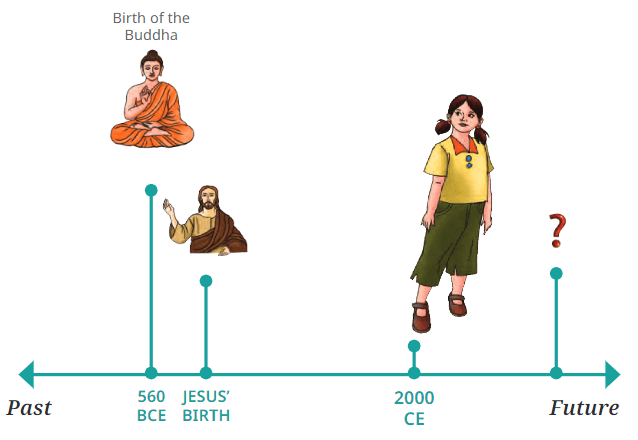
- Timelines also make it easier to understand when events happened compared to each other. For example, even without knowing the exact years, you can easily see that Buddha was born before Jesus just by looking at their positions on the timeline.
Understanding Centuries and Millenniums
In addition to talking about years and decades (which are periods of ten years), we also use other terms to describe longer stretches of time.
Here are two important ones:
- Century: A century is 100 years. We count centuries in history every 100 years starting from 1 CE. For example, we are in the 21st century CE, which goes from 2001 to 2100. Centuries before the Common Era (BCE) are also counted in 100-year periods, but backward. For instance, the 3rd century BCE includes the years from 300 BCE to 201 BCE.
- Millennium: A millennium is 1,000 years. We count millenniums starting from 1 CE. For example, we are in the 3rd millennium CE, which started in 2001 CE and will end in 3000 CE. Millenniums BCE are also counted backward. For instance, the 1st millennium BCE includes the years from 1000 BCE to 1 BCE.
Therefore,
- A century = 100 years
- A millennium = 1,000 years
Both centuries and millenniums can be counted forward (CE) or backward (BCE).
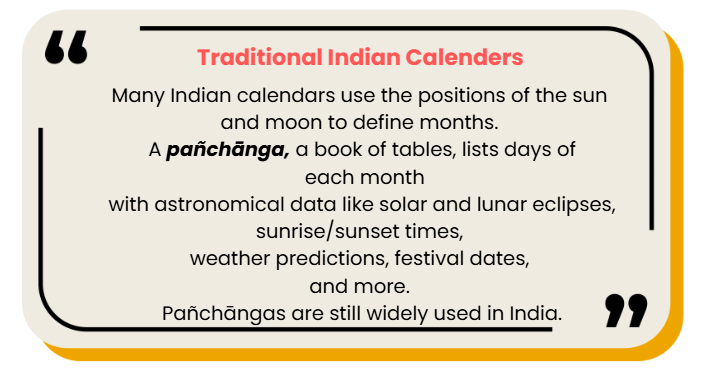
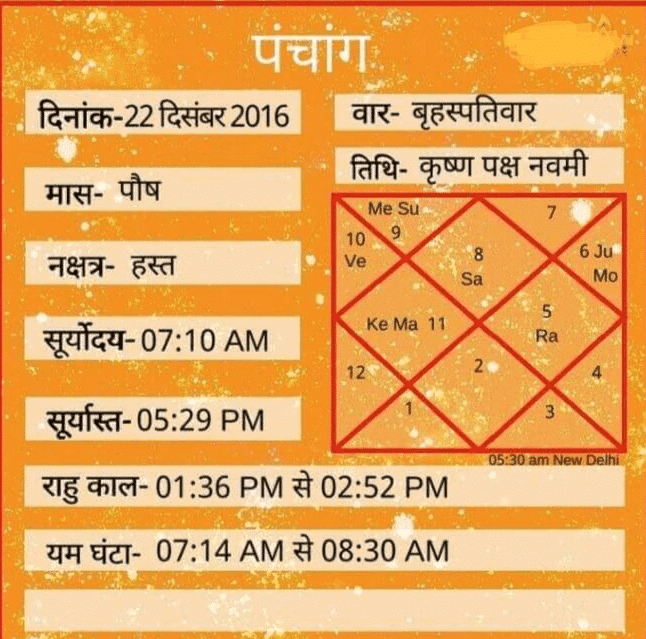
Example of Pañchāngas
What Are the Sources of History?
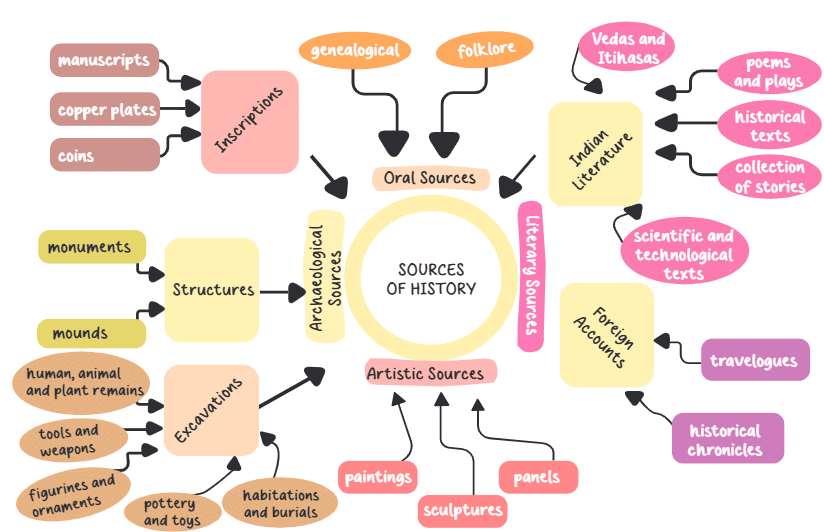
Main Sources of History
- When historians study history, they use many different sources of information.
- These sources help them learn about things like ancient kings and queens, old monuments, wars, and trade items from long ago.
- Historians try to gather information from as many sources as possible to get a complete picture.
Matching the Pieces
- Historians often compare different sources of information. Sometimes, the sources agree with each other, like pieces of a puzzle that fit together perfectly.
- Other times, the sources might tell different stories, like puzzle pieces that don’t match. When this happens, historians have to decide which sources to trust more.
Who Helps Create History?
Historians aren’t the only ones who contribute to our understanding of the past.
They get help from:
- Archaeologists: Who study ancient artifacts and remains.
- Epigraphists: Who study ancient inscriptions.
- Anthropologists: Who study human societies and cultures.
- Literature and Language Experts: Who help understand old writings.
Scientific Studies
- In recent times, science has also become important in studying history.
- For example, scientists study ancient climates, analyze materials found during excavations, and even study the genetics of ancient people.
- These scientific methods give historians new information that adds to what they learn from other sources.
Recent History
- When studying more recent history (from the last two or three centuries), historians use newspapers as sources.
- For the past few decades, electronic media like television and the internet have also become valuable tools for understanding history.
The Beginnings of Human History
Can you name one way early humans made their lives easier?
Yes, early humans made their lives easier by using tools like stone axes and arrowheads, which helped them hunt, build, and protect themselves.
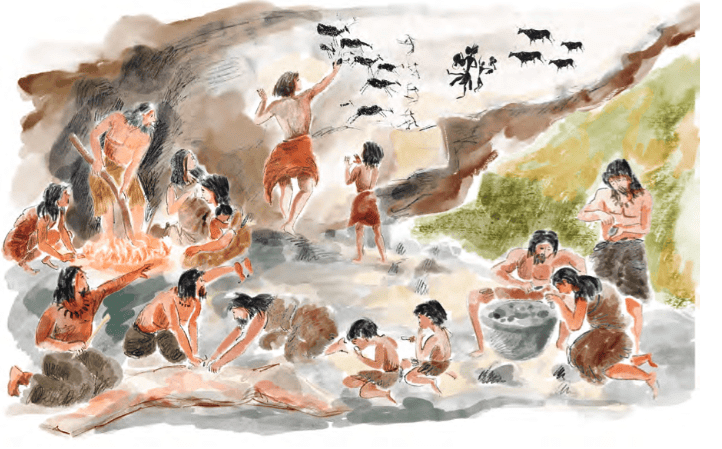
Modern humans, called Homo sapiens, have been on Earth for about 300,000 years. While this seems like a long time, it is only a small part of Earth's history.
Let's take a quick look at how early humans lived.
- Early Human Survival: Early humans had to deal with many challenges from nature, so they lived in groups to help each other. They were always looking for shelter and food, mainly by hunting animals and gathering plants and fruits. They also had some beliefs about nature and possibly thought about what happens after death.
- How Early Humans Lived: These groups lived in temporary places like camps, rock shelters, or caves. They communicated using languages that we no longer know. They used fire and started making tools like stone axes, blades, and arrowheads to make life easier. We can see parts of their life in rock paintings found in caves around the world.
- Rock Paintings, Jewelry and Trade: Some paintings show simple figures or symbols, while others show detailed scenes with animals or people. Over time, early humans also learned to make simple jewelry like beads and pendants from stones, shells, or animal teeth, and they sometimes traded these with other groups.
The First Crops
- Climate Changes and the Ice Age: Over many years, the Earth's climate has changed a lot. Sometimes it was very cold, and a large part of the Earth was covered with ice. This time is called the Ice Age.
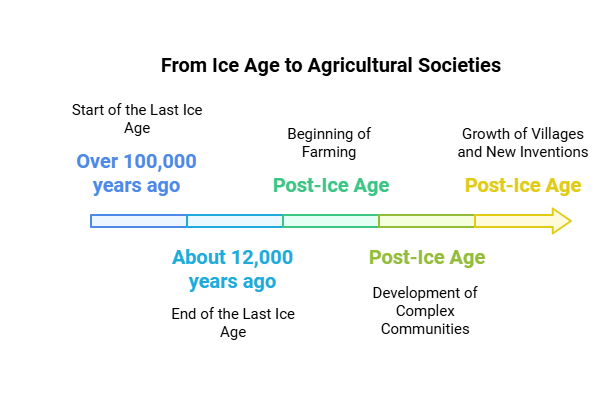
- The End of the Ice Age: Later, when the weather warmed up, some of the ice melted, and the water flowed into rivers and oceans. The last Ice Age started over 100,000 years ago and ended about 12,000 years ago.
- The Beginning of Farming: After the ice age, life became easier for humans. In many places, people began to settle down and grow crops like cereals and grains. They also started keeping animals like cattle and goats.
- Settlements Near Rivers: With more food available, their communities grew bigger, and they often settled near rivers. This was because they needed water, and the soil near rivers was more fertile, which made it easier to grow crops.
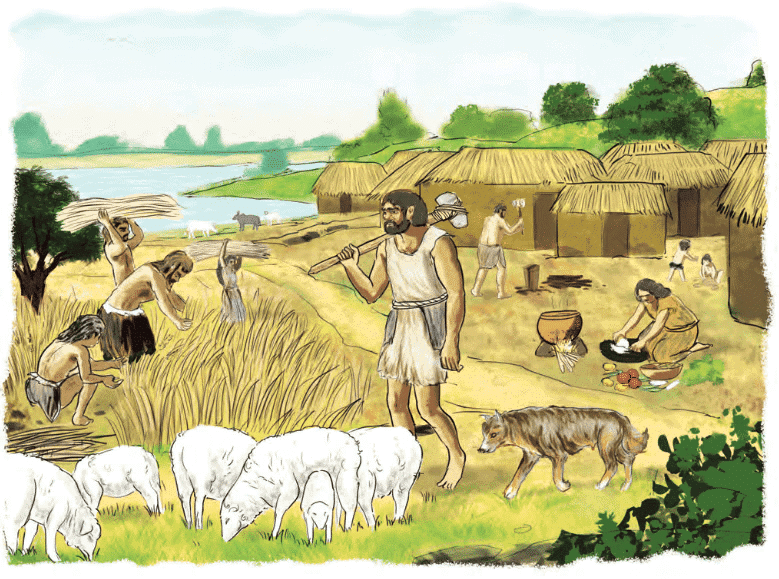
- Development of Complex Communities: As communities grew, they became more complex. Leaders, called chieftains, took care of the people, and everyone worked together for the community’s benefit. There was no private land; instead, everyone shared the land for growing and harvesting crops.
- Growth of Villages and New Inventions: Over time, small villages grew bigger and started trading goods like food, clothes, and tools with each other. Some villages became small towns, and people invented new technologies like pottery for making clay pots and metal tools for daily use.
Key Words
- History: The study of the human past.
- Fossils: Impressions of footprints, or parts of plants or animals that are found preserved within layers of soil or rocks.
- Era: A distinct period of time.
- Gregorian calendar: The calendar is now used the world over; it has 12 months adding up to 365 days, and a leap year every four years. However, century years — for example, 1800, 1900, and 2000 — are years only if they are multiples of 400; so in the three centenary years above, only 2000 is a leap year.
- Auspicious: Favourable or bringing luck; for instance, 'an auspicious beginning'.
- Source of history: A place, person, text, or object from which we gather information about some past event or period.
- Historian: A person who studies and writes about the past.
- Genetics: The branch of biology that studies how, in plants, animals, or humans, certain features and characteristics get passed down from one generation to the next.
- Afterlife: A life that begins after death.
- Welfare: Health, prosperity,y and well-being.
- Hamlet: A small settlement or small village.
FAQs on Timeline and Sources of History Chapter Notes - Chapter Notes For Class 6
| 1. How is time measured in history? |  |
| 2. What are the main sources of history? |  |
| 3. What are the significant milestones in the beginnings of human history? |  |
| 4. What were the first crops cultivated by humans? |  |
| 5. Why is understanding the timeline of history important? |  |
















